Better Kinetics with MXene-based Electrocatalysts in Fuel Cells
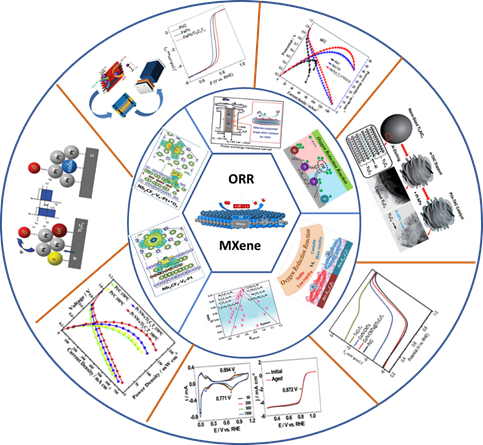 A cutting-edge research paper on MXene-based electrocatalysts for fuel cells has been published by Dr Lakhveer Singh of the Department of Environmental Sciences. In the journal of Advanced Materials Interfaces, Impact factor 6.14, his paper, titled “Recent Advances on MXene-Based Electrocatalysts toward Oxygen Reduction Reaction: A Focused Review”, has been published in collaboration with Dr S. G. Peera and Dr. T. G. Lee from the Department of Environmental Science and Engineering Keimyung University Daegu 42602, Republic of Korea.
A cutting-edge research paper on MXene-based electrocatalysts for fuel cells has been published by Dr Lakhveer Singh of the Department of Environmental Sciences. In the journal of Advanced Materials Interfaces, Impact factor 6.14, his paper, titled “Recent Advances on MXene-Based Electrocatalysts toward Oxygen Reduction Reaction: A Focused Review”, has been published in collaboration with Dr S. G. Peera and Dr. T. G. Lee from the Department of Environmental Science and Engineering Keimyung University Daegu 42602, Republic of Korea.
Oxygen reduction reaction (ORR) takes place in the fuel cells. Improving the kinetics of the reaction would be a major step in improving the efficiency of the fuel cells. Extensive studies have been done to find cathode catalysts that are both highly active and also maintain stability in a corrosive environment. Recent research has been leaning towards 2D materials owing to the larger surface area they provide for catalyst dispersion. MXene-based catalysts have become popular due to their impressive electrical conductivity as well as their thermal and chemical stability.
A summary of Dr Singh’s paper:
MXene, a novel transition metal carbide and/or nitride based two-dimensional material has been gaining a considerable interest in the field of energy storage and conversion, due to their unique layered structure, electronic properties, and surface chemistry, that are beneficial for various electrochemical reactions. Most of the MXenes research done so far is in the field of supercapacitors, batteries, overall water splitting, and other catalytic applications. The research done on fuel cell cathodic oxygen reduction reaction (ORR) is scarce. There is a need for intensive review on Mxenes. Uniquely, this review article describes the ORR catalysis of MXene based catalysts both in theoretical and experimental view.
In future they plan to work on investigations on theoretical and computational screening to elucidate the ORR mechanism, stability, and strategies for improving the electrocatalytic activity of MXene catalysts; these studies can serve as a guide for experimentalists, especially for selecting optimal catalyst compositions.
- Published in News
Prof Indranath Sengupta to illuminate on the unboundedness of Betti numbers
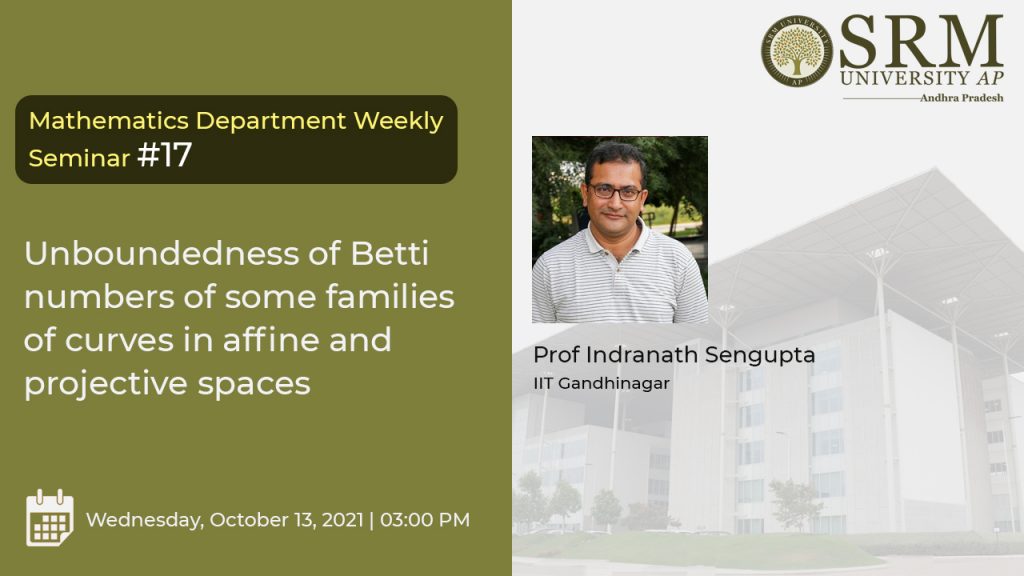 Department of Mathematics is organising the 17th Departmental Weekly Seminar on October 13, 2021, at 3 pm. Prof Indranath Sengupta from IIT Gandhinagar will be addressing the students on “Unboundedness of Betti numbers of some families of curves in affine and projective spaces”. Prof Indranath Sengupta will discuss some problems related to the unboundedness of Betti numbers of families of affine curves defined by Numerical semigroups. He will also indicate possible connections, with the help of examples, between the unboundedness of the last Betti number and the Cohen-Macaulayness of the projective closure of these affine curves. This work has been carried out in collaboration with Ranjana Mehta, Joydip Saha & Pranjal Srivastav.
Department of Mathematics is organising the 17th Departmental Weekly Seminar on October 13, 2021, at 3 pm. Prof Indranath Sengupta from IIT Gandhinagar will be addressing the students on “Unboundedness of Betti numbers of some families of curves in affine and projective spaces”. Prof Indranath Sengupta will discuss some problems related to the unboundedness of Betti numbers of families of affine curves defined by Numerical semigroups. He will also indicate possible connections, with the help of examples, between the unboundedness of the last Betti number and the Cohen-Macaulayness of the projective closure of these affine curves. This work has been carried out in collaboration with Ranjana Mehta, Joydip Saha & Pranjal Srivastav.
Mathematics Departmental Seminar is widely popular among students and Mathematics enthusiasts. This seminar provides a homey environment where students can interact with renowned mathematicians. Eminent mathematicians and scholars have visited SRM University-AP and enjoyed conversations with students. Everyone is encouraged to take part in the exciting journey through the realms of Mathematics with Prof Indranath Sengupta on October 13, 2021, at 3 pm.
- Published in Events, Math Events
Career Development Guidance to Upgrade From “Option” to “Preference”
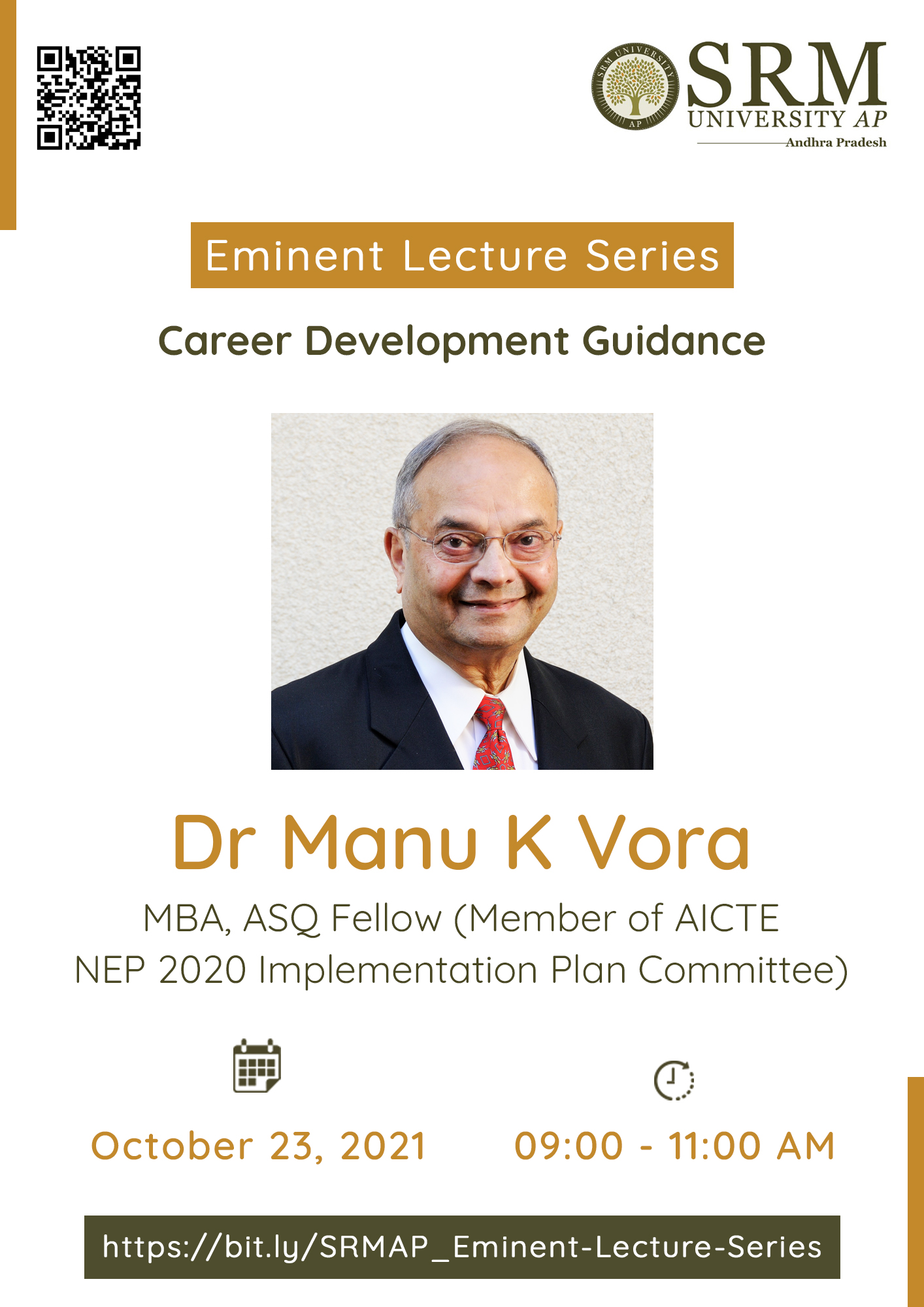 Career development skills are the difference between the person who seeks inspiration and the person who becomes one. SRM University-AP is happy to introduce Dr Manu K. Vora, a world-renowned mentor and facilitator to our Master’s students, PhD scholars and faculty members on October 23, 2021, Saturday from 9.00 am to 11.00 am for a session on “Career Development Guidance”.
Career development skills are the difference between the person who seeks inspiration and the person who becomes one. SRM University-AP is happy to introduce Dr Manu K. Vora, a world-renowned mentor and facilitator to our Master’s students, PhD scholars and faculty members on October 23, 2021, Saturday from 9.00 am to 11.00 am for a session on “Career Development Guidance”.
Dr Vora is an ASQ (American Society of Quality) fellow and had previously served as Vice-President of ASQ Board of Directors and Chairperson of ASQ Chicago Section. He is also a member of AICTE-NEP 2020 Implementation Plan Committee. He had received his B. Tech degree from IIT, BHU and his M.S. and PhD from IIT, Chicago. He also has an MBA degree specializing in Marketing Management from Keller GSM in Chicago.
He has till date developed and offered career development and enhancement skills to over one million people. Dr Vora has also been featured in TED Talks both in India and USA. He has received 56 awards for professional soft skills and leadership development. But his contribution is not just limited to the professional skillsets with which he equips his audience. He has also received 35 awards for his philanthropic activities and has been the President of the Blind Foundation of India since 1989.
Presently, the President and the Chairperson of Business Excellence, Dr Vora has 46 years of Leadership experience guiding Fortune 500 companies and 28 years as Adjunct Faculty Globally in Operations Management. He has so far delivered 1170 presentations, published 70 scholarly articles, written 50 blogs on Quality Management and contributed his skills for the development of 680 educational institutes around the world.
To have such an eminent personality guide us is an opportunity second to none. We believe it will give our Master’s students and PhD scholars the career enhancement skills on which to build their presence in our brand and to develop the career development skills that would make them feathers in our cap. Make use of this exclusive opportunity to acquire the skills that are a match to the global leaders on October 23, 2021, Saturday from 9.00 am to 11.00 am with Dr Manu K. Vora.
Register to Join: https://bit.ly/SRMAP_Eminent-Lecture-Series
- Published in Events
Dr Md Asadul Haque
- Published in Assistant Professor, Faculty, Management Faculty, SEAMS
Asphalt materials characterization: Trends and challenges
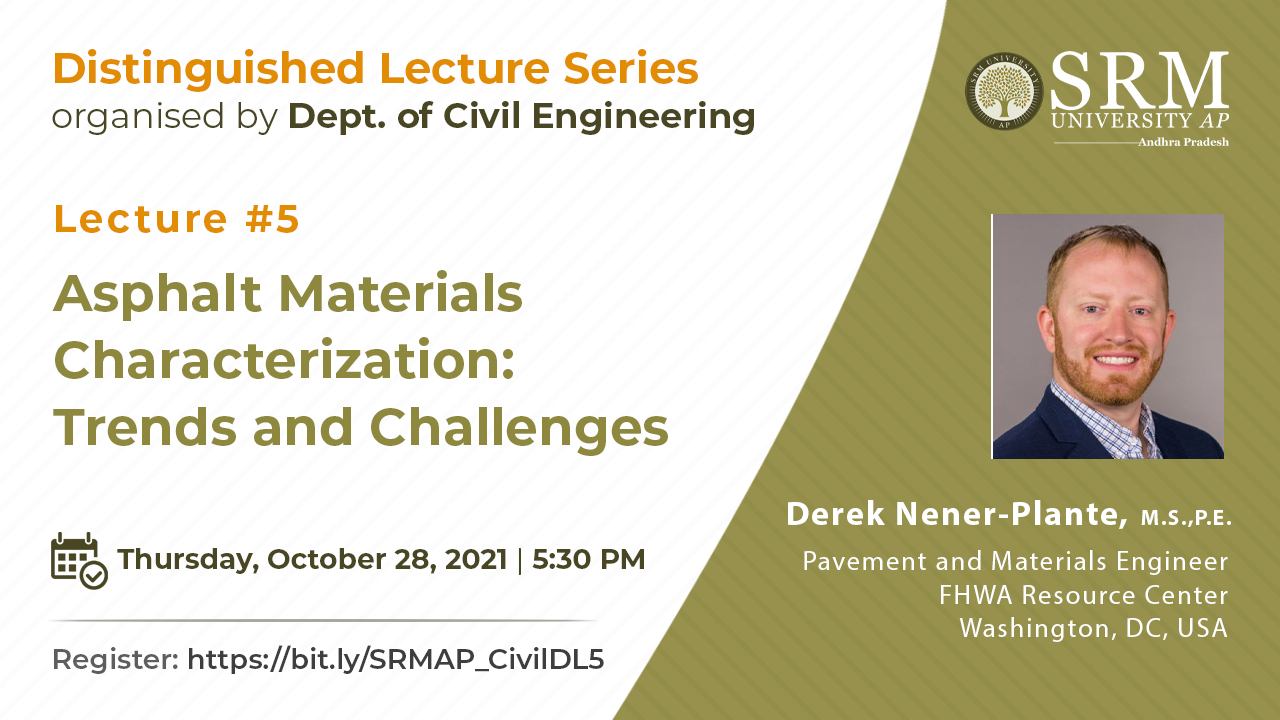 The Department of Civil Engineering at SRM University-AP organises the fifth lecture in the Distinguished Lecture Series on October 28, 2021, at 5:30 pm. Renowned Pavement and Materials Engineer, Derek Nener-Plante, M.S, P.E from FHWA Resource Center, Washington, DC, USA will engage the session on the topic “Asphalt Materials Characterization: Trends and Challenges”. The lecture aims to throw light on balanced mixture design, sustainability, quality assurance and related areas.
The Department of Civil Engineering at SRM University-AP organises the fifth lecture in the Distinguished Lecture Series on October 28, 2021, at 5:30 pm. Renowned Pavement and Materials Engineer, Derek Nener-Plante, M.S, P.E from FHWA Resource Center, Washington, DC, USA will engage the session on the topic “Asphalt Materials Characterization: Trends and Challenges”. The lecture aims to throw light on balanced mixture design, sustainability, quality assurance and related areas.
About the speaker
Derek is a Pavement and Materials Engineer for the FHWA Pavement and Materials Technical Services Team. He is responsible for leading implementation and deployment efforts in the areas of asphalt materials, asphalt pavement construction, materials and construction specifications, and quality assurance. Prior to joining the Resource Center in March 2020, Derek worked at MaineDOT for nearly ten years as the state asphalt pavement engineer. Derek earned his Master’s of Science in Transportation Engineering from the University of Connecticut and is a registered Professional Engineer.
All students are encouraged to make use of this informative session on October 28, 2021, at 5:30 pm to know more about the trends and challenges in the asphalt materials characterisation.
- Published in Civil Engg events, Departmental Events, Events, Webinars
Network Your Way Through with ‘Alumni Connect Programme’
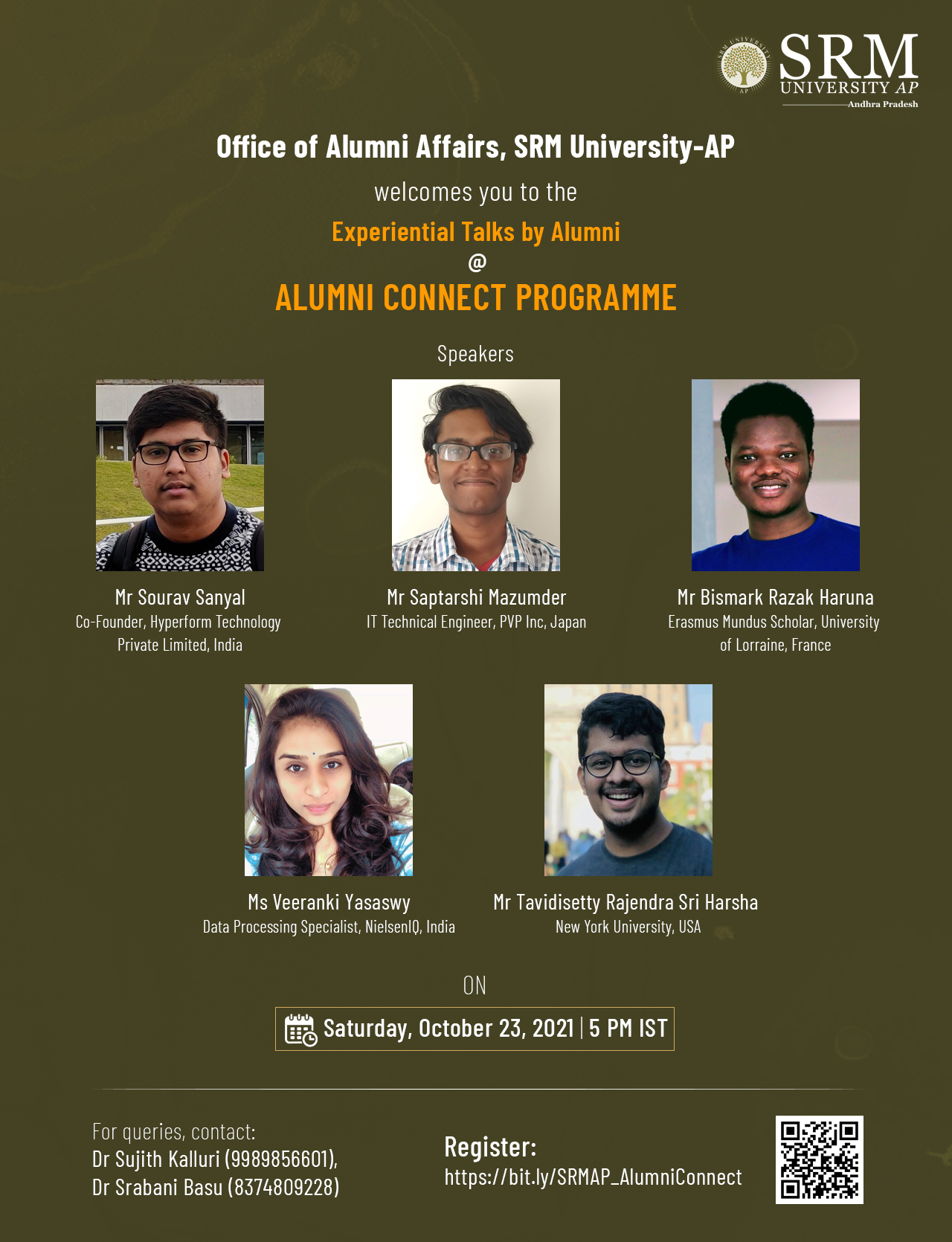 Our alumni are not just our brand ambassadors but also the perfect network opportunity for current students to learn the nitty-gritty of professional acumens. SRM University-AP is elated to bring forward its alumni from many walks of life to share their experiences in an exclusive session on October 23, 2021, Saturday from 5 pm IST onwards in its Alumni Connect Programme.
Our alumni are not just our brand ambassadors but also the perfect network opportunity for current students to learn the nitty-gritty of professional acumens. SRM University-AP is elated to bring forward its alumni from many walks of life to share their experiences in an exclusive session on October 23, 2021, Saturday from 5 pm IST onwards in its Alumni Connect Programme.
This is an opportunity for all SRM University-AP students to get insights from the real-life experience of their alumni. The alumni will help the current students to have a clearer view of their future and the pathways available to them. The students can choose to emulate their inspirations or choose an entirely unexplored avenue for themselves.
Dr P Sathyanarayanan, President, SRM University-AP will inaugurate this event and deliver the inaugural address to motivate both the current students and the alumni. The inaugural address will be followed by the message from Prof V S Rao, Vice-Chancellor, SRM University-AP. The event will move forward with another message by Prof D Narayana Rao, Pro-Vice-Chancellor, SRM University-AP. After the addresses by the esteemed dignitaries, the Alumni Yearbook-2021 would be launched by the President in the presence of the Vice-Chancellor and the Pro-Vice-Chancellor.
The event will be further advanced with talks given by the Alumni. Their journey will help the students understand the framework of professional possibilities better. Students will be able to plan their co-curricular skills more accurately during their time in the University to do better in the placement drive to land their dream jobs in their dream companies with a sought-after salary.
Those who are interested in pursuing higher education in world-renowned Universities will learn about the procedures and aids that were availed by our alumni during their turns. This will help them plan their education responsibly.
Moreover, those who dream to be entrepreneurs in future would benefit from the know-hows of their predecessors about the challenges both expected and unexpected and how their alumni were able to overcome those. The importance of ‘networking with other entrepreneurs and gaining knowledge from their perspectives’ cannot be overstated for aspiring businessmen.
At the end of the event, Ms Revathi B, Assistant Director, Student Affairs would facilitate the stage for interaction between the current and the former students. To conclude the event, Dr Sujith Kalluri, Assistant Director, Alumni Affairs would offer a concluding speech to mark the closing of the event.
Join the event on October 23, 2021, Saturday from 5 pm IST to take this opportunity to see what your future might look like after SRM University-AP with our Alumni Connect Programme.
Register to Join: https://bit.ly/SRMAP_AlumniConnect
- Published in Events
Impact of Surface Chemistry on the Excited State Interactions of CsPbBr3
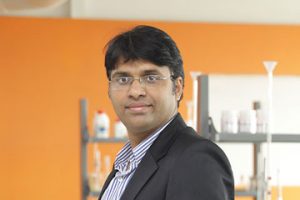 Dr Nimai Mishra, Assistant Professor, Department of Chemistry, SRM University-AP along with his team comprising of his PhD scholars Mr. Syed Akhil, Ms. V.G.Vasavi Dutt, and Mr Rahul Singh have published a research article titled “Surface-State-Mediated Interfacial Hole Transfer Dynamics Between CsPbBr3 Perovskite Nanocrystals and Phenothiazine Redox Couple” in The Journal of Physical Chemistry-C, published by The American Chemical Society with an impact factor of ~4.126.
Dr Nimai Mishra, Assistant Professor, Department of Chemistry, SRM University-AP along with his team comprising of his PhD scholars Mr. Syed Akhil, Ms. V.G.Vasavi Dutt, and Mr Rahul Singh have published a research article titled “Surface-State-Mediated Interfacial Hole Transfer Dynamics Between CsPbBr3 Perovskite Nanocrystals and Phenothiazine Redox Couple” in The Journal of Physical Chemistry-C, published by The American Chemical Society with an impact factor of ~4.126.
Dr Mishra’s research interests lie in Semiconductor nanocrystals, Core/shell branched structures, Nanowires, Perovskite nanocrystals and Optoelectronic device fabrication. He studied the role of surface chemistry for improving excited state hole transfer from CsPbBr3 nanocrystals to an acceptor, potentially applicable for photocatalytic applications.
About the research:
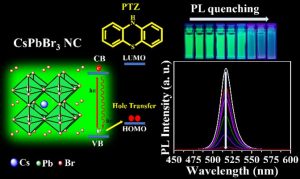 Recently, caesium lead bromide (CsPbBr3) perovskite nanocrystals (PNCs) gained enormous attention for designing photocatalytic reactions because of their photocatalytic properties. But the surface chemistry of nanocrystals is often ignored which dictate the excited state interactions of these semiconductor nanocrystals with the charge shuttling redox-active molecules. In this work, we have explored the impact of CsPbBr3 perovskite nanocrystals with the three different surface chemistries on the excited state interactions with the standard hole acceptor phenothiazine molecule. From the steady PL-lifetime decay measurements we have calculated the photoinduced hole transfer (PHT). In the amine-free PNCs case, PHT is 6 times higher than the conventional amine capped ligands. Using the lifetime fast component (1) rate constants, we have calculated the hole transfer constant (kht) which is 3.942 × 108 s-1 and it is 4 times higher in amine-free ligands when compared with conventional amine ligands system.
Recently, caesium lead bromide (CsPbBr3) perovskite nanocrystals (PNCs) gained enormous attention for designing photocatalytic reactions because of their photocatalytic properties. But the surface chemistry of nanocrystals is often ignored which dictate the excited state interactions of these semiconductor nanocrystals with the charge shuttling redox-active molecules. In this work, we have explored the impact of CsPbBr3 perovskite nanocrystals with the three different surface chemistries on the excited state interactions with the standard hole acceptor phenothiazine molecule. From the steady PL-lifetime decay measurements we have calculated the photoinduced hole transfer (PHT). In the amine-free PNCs case, PHT is 6 times higher than the conventional amine capped ligands. Using the lifetime fast component (1) rate constants, we have calculated the hole transfer constant (kht) which is 3.942 × 108 s-1 and it is 4 times higher in amine-free ligands when compared with conventional amine ligands system.
According to Dr Nimai Mishra, the most important contribution of this research is that these results highlight the impact of surface chemistry on the excited state interactions of CsPbBr3 PNCs and conclude amine-free PNCs could be an ideal candidate for photocatalytic reactions.
Read the full paper: https://pubs.acs.org/doi/10.1021/acs.jpcc.1c07129
- Published in Chemistry-news, News, Research News
Securing Online Payments made through Wearable Devices
Smart devices and Internet of Things (IoT) are growing in importance every day and so do our security concerns about using them for our financial transactions. As we carry the world with us through wearable technology, Dr Sriramulu Bojjagani, Assistant Professor, Department of Computer Science Engineering works towards making wearable devices more secure.
With a thriving interest in Cyber Security, Formal Verification Methods and Vulnerability Analysis and Penetration Testing, Dr Bojjagani has recently published his paper on “A Secure IoT-based Micro-payment Protocol for Wearable Devices” in Peer-to-Peer Networking and Applications (PPNA), Springer.DOI: 10.1007/s12083-021-01242-y
Abstract:
Wearable devices are one of the parts of the essential cost of goods sold (COGS) in the wheel of the Internet of things (IoT), contributing towards a potential impact in the finance and banking sectors. There is a need for lightweight cryptography mechanisms for IoT devices because these are resource constraints. This paper introduces a novel approach to an IoT-based micro-payment protocol in a wearable device’s environment. This payment model uses “elliptic curve integrated encryption scheme (ECIES)” for encryption and decryption of the communicating messages between various entities. The proposed protocol allows the customer to buy the goods using a wearable device and send the mobile application’s confidential payment information. The application creates a secure session between the customer, banks, and merchant. The static security analysis and informal security methods indicate that the proposed protocol is withstanding the various security vulnerabilities involved in mobile payments. For logical verification of the correctness of security properties using the formal way of “Burrows-Abadi-Needham (BAN)” logic confirms the proposed protocol’s accuracy. The practical simulation and validation using the Scyther and Tamarin tool ensure the absence of security attacks in our scheme. Finally, the performance analysis based on cryptography features and computational overhead of related approaches specify that the proposed micro-payment protocol for wearable devices is secure and efficient.
Architecture for wearable devices:
The architecture for wearable devices is shown in Fig. 1. It consists of six types of entities, such as Issuer bank (IB), acquirer bank (AB), payment gateway (PG), a certification authority (CA), mobile terminal, and wearable sensing devices. The person using various wearable devices such as a smartwatch, smart wristband, smart glass, etc. In the architecture, a wearable device is connected to the mobile terminal through NFC. An app is running on a mobile device. Wearable devices are resource constraints because they have limited computing capabilities regarding battery, display, storage, and processing compared to a mobile terminal (smartphone). Hence, NFC is used to pair the wearable device and mobile terminal for transmitting public messages. Before conducting any transaction with the merchant, the customer and merchant should register their mobile numbers with the bank.
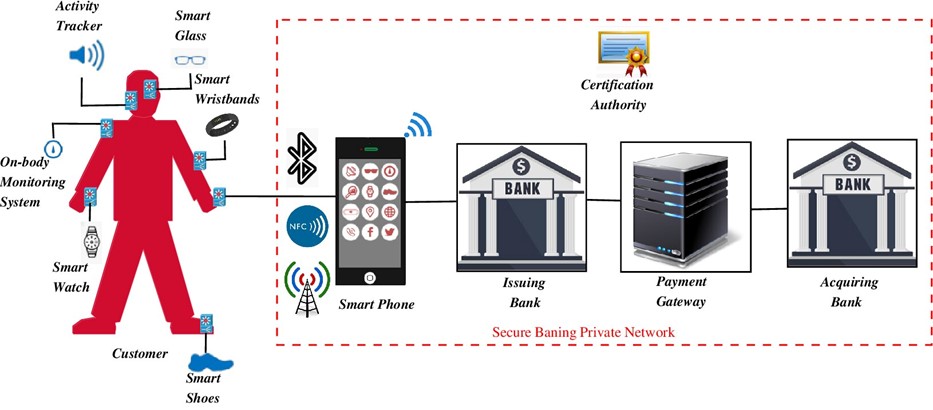
Fig. 1. Architecture for wearable devices
The customer can place an order with the merchant using the following steps and the complete messages flow in the proposed protocol is shown shown in the Figure.
● The customer places an order for an item through a wearable device.
● The request is transferred to the mobile app. The mobile app verifies the user authentication.
● After a successful authentication request, the app forwarded the request to the issuing bank for payment verification.
● The customer also sends a payment request for a deduction of the amount from his/her issuing bank.
● Once the bank validates the customer data in terms of sufficient funds available and user’s integrity. The issuing bank routes the transaction to the payment gateway through a secure network.
● In this step, the payment gateway verified the customer payment order and transferred it to the acquiring bank.
● If all the verifications are successful, then the transaction amount is then debited from the issuing bank and credited to the merchants’ acquiring bank.

Application demonstration:
As we know, most wearable devices run the Android operating system. The proposed framework developed as an Android application package (APK) file run in an Android wearable emulator, but we have operated in the Samsung Galaxy Note-2 device due to limits of the screen device and lack of environment. First, it needs to install the APK file and start running the app. Before running the app, some points need to be considered, such as the following:
● The company voice gateway provided for the service of an SMS gateway connected to Xeon server and assigned us a shortcode 56677.
● The payment gateway switch is used to communicate with the customer and merchant bank accounts.
● Two mobile numbers are registered with the banks and telecom operations, and it is used for SMS service.
● The deployed decryption web application on the Xeon server.
● HTTPS connection is used between voice gateway and Xeon server established Indian financial network (INFINET) link between server and bank.
We have not mentioned all the screenshots for the app from starting the login and authentication phase, but the protocol requires the essential information only shown in the screenshot. We didn’t mention the banks considered for implementing the micro-payment protocol for security and reputation reasons.
The proposed protocol action is as follows:
Step 1: The customer x runs a wearable application to enter Wearable-id, mobile number, pin and amount and sends an encrypted message to the Xeon server via short-code 56677. To encrypt the message, the customer may choose any one of the ECC curves as shown in Fig. 2.
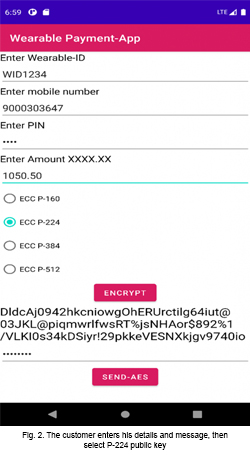
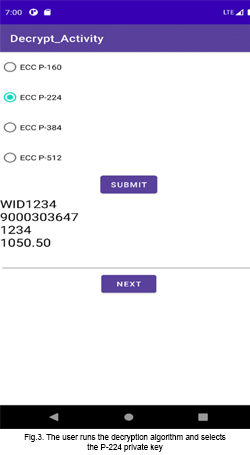
Step 2: The SMS gateway receives the encrypted SMS, which is delivered to the server
Step 3: The server receives the encrypted SMS and executes the decryption application. Next, the user runs decryption activity and selects the P-224 private key. After decryption, the message is shown in Fig. 3.
Step 4: After the message is decrypted, the user presses the “Next” button to communicate with the payment gateway.
Step 5: Now, the merchant fills in the remaining fields of merchant UPI-id, mobile number, and purpose of payment and then selects any payment gateway as shown in Fig. 4.
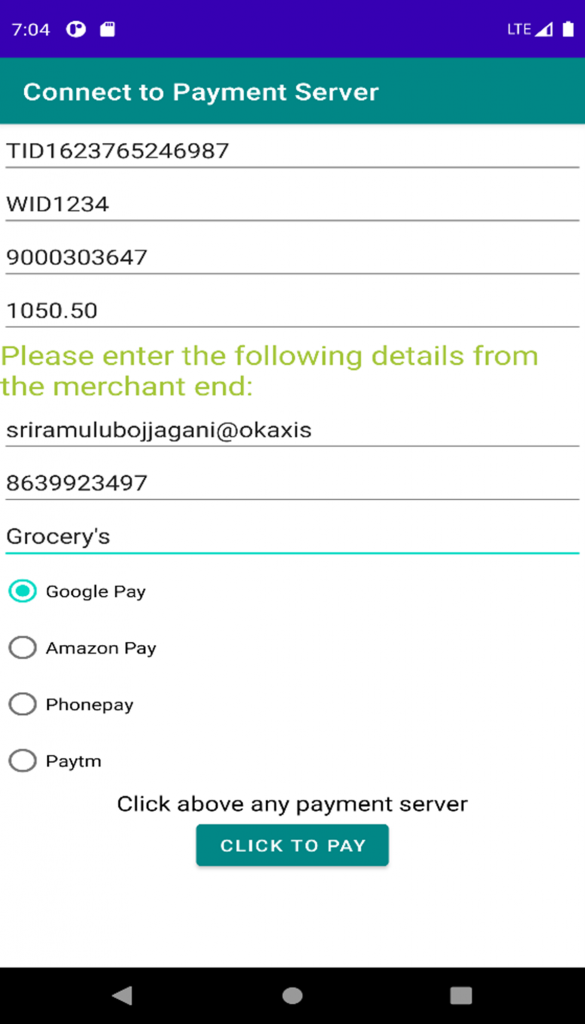
Fig. 4: The merchant enters the details and sends to any payment server
Dr Bojjagani’s research will further refine the parameters of security in IoT enabling wearable devices to become smarter and safer.
- To make the proposed protocols more secure can add biometric-based authentication can be added.
- The future directions of the proposed framework fit only for micro-payments. In future, we have upgraded to credit card/debit card payments to enhance the proposed framework for macro-payments.
- Published in CSE NEWS, News, Research News
Distinguished lecture on India’s initiatives on polar and ocean research
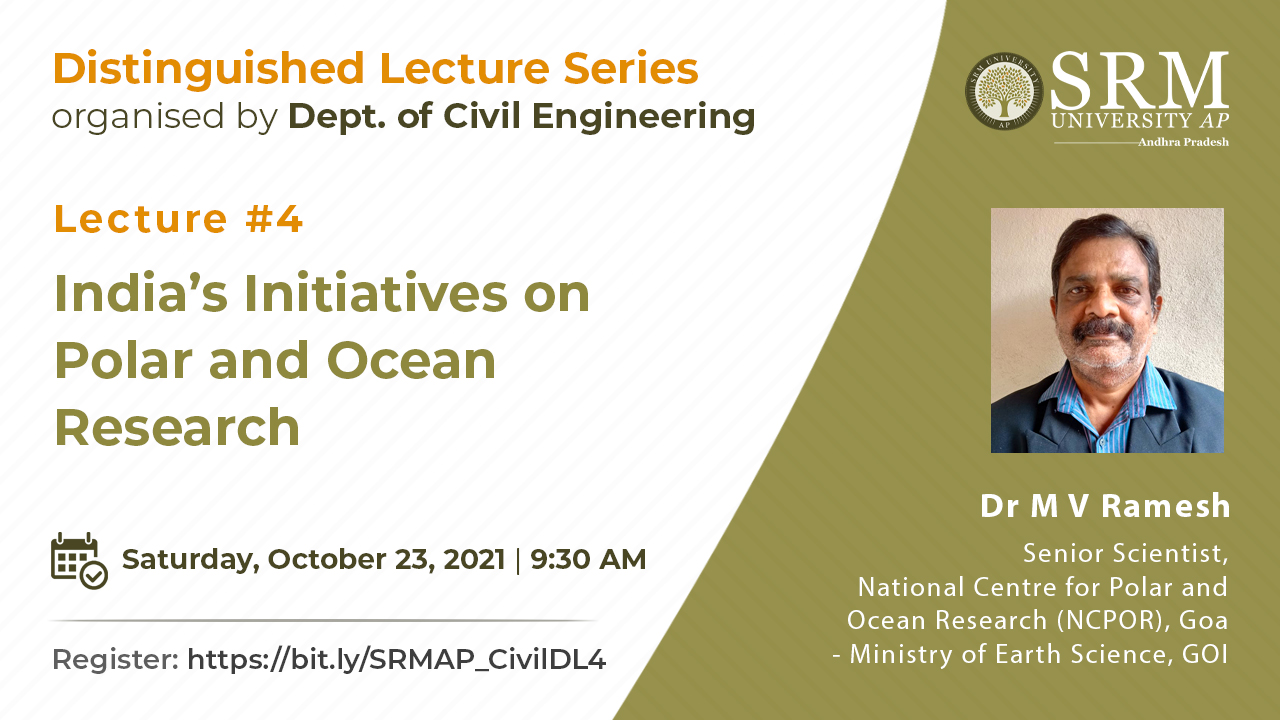 The Distinguished Lecture Series organised by the Department of Civil Engineering at SRM University-AP offers a congenial atmosphere in which students can connect with eminent scientists. The fourth episode in the series is scheduled to be held on October 23, 2021 (Saturday) from 9:30 am to 10:30 am. Dr M V Ramesh, Senior Scientist, National Centre for Polar and Ocean Research (NCPOR), Goa – Ministry of Earth Science, GOI will be the guest speaker to deliver the lecture.
The Distinguished Lecture Series organised by the Department of Civil Engineering at SRM University-AP offers a congenial atmosphere in which students can connect with eminent scientists. The fourth episode in the series is scheduled to be held on October 23, 2021 (Saturday) from 9:30 am to 10:30 am. Dr M V Ramesh, Senior Scientist, National Centre for Polar and Ocean Research (NCPOR), Goa – Ministry of Earth Science, GOI will be the guest speaker to deliver the lecture.
The lecture will cover topics such as the scientific programmes focusing on bipolar activities i.e. Antarctica as well as Arctic multi-disciplinary approach studies. Logistic support provided for Antarctica in particular as a nodal agency, LCS(Legal Continental Shelf), Bathymetric surveys of EEZ(Exclusive Economic Zone) in the deeper waters, Southern ocean Oceanography which is supposed to control the monsoon of India as well as South Asian countries will also be discussed. Other topics include ice core analysis of Antarctica for the better understanding of paleoclimate, polar remote sensing studies, and cryospheric studies in polar regions and Himalayas.
About the speaker
Dr M V Ramesh is a Senior Scientist and coordinator who obtained his doctorate (PhD) from Andhra University, Visakhapatnam in 1994 in Marine Geology. He worked on sedimentology and Geochemistry primarily on continental shelf sediments off Kalingapatnam-Pentakota, the East coast of India. He has pursued his post-doctoral course in a DST sponsored project- a collaboration project between Geology and Anthropology at Andhra University, Visakhapatnam. He had been deputed to Adikavi Nannaya University as a Visiting Scientist for one year during 2007-2008 and his teaching services have been availed off successfully to the students of Department of Geo-informatics in the I, II, and III semesters for a period of nearly 1 year He had been deputed to various multi-disciplinary cruises ( inclusive in the capacity as Deputy Chief scientist) as many as 18 in Number comprising 450 ship days inclusive of EEZ surveys/cruises, Post Tsunami multi-disciplinary cruise off Andaman & Nicobar Islands, exploration of polymetallic nodules on onboard Sagar Kanya and including the one Southern Ocean Expedition(2009) which proceeded up to 66.5◦S i.e. touching the Antarctica waters on onboard Academic Boris Petrov a Russian vessel. He had been deputed to Oman in Indo-US-Oman multidisciplinary cruise for a period of 14 days onboard Sagar Kanya. Altogether, he had been deputed 850 days on official duties. He has to his credit 36 scientific papers in various National as well as International Journals related to the Bay of Bengal, Arabia and in oceanography as a whole. His research areas are primarily sedimentology, clay mineralogy primarily off-shelf sediments and deep-sea sediment cores. He had worked on RS studies and GIS Technologies in NRSA, Ministry of space, Hyderabad for a period of 12 weeks during 2006-07. He has been actively involved in Outreach activities for more than 10 years in giving his services to students, Professors, Scientists and delegates from four corners of the Nation as well abroad (schools, colleges, universities and R&Ds).
Join this intriguing online lecture on October 23, 2021, at 09.30 am and enrich your knowledge through the scholarly voice of Dr M V Ramesh!
- Published in Civil Engg events, Departmental Events, Events, Webinars
Exciting dream salary in dream company BARCLAYS
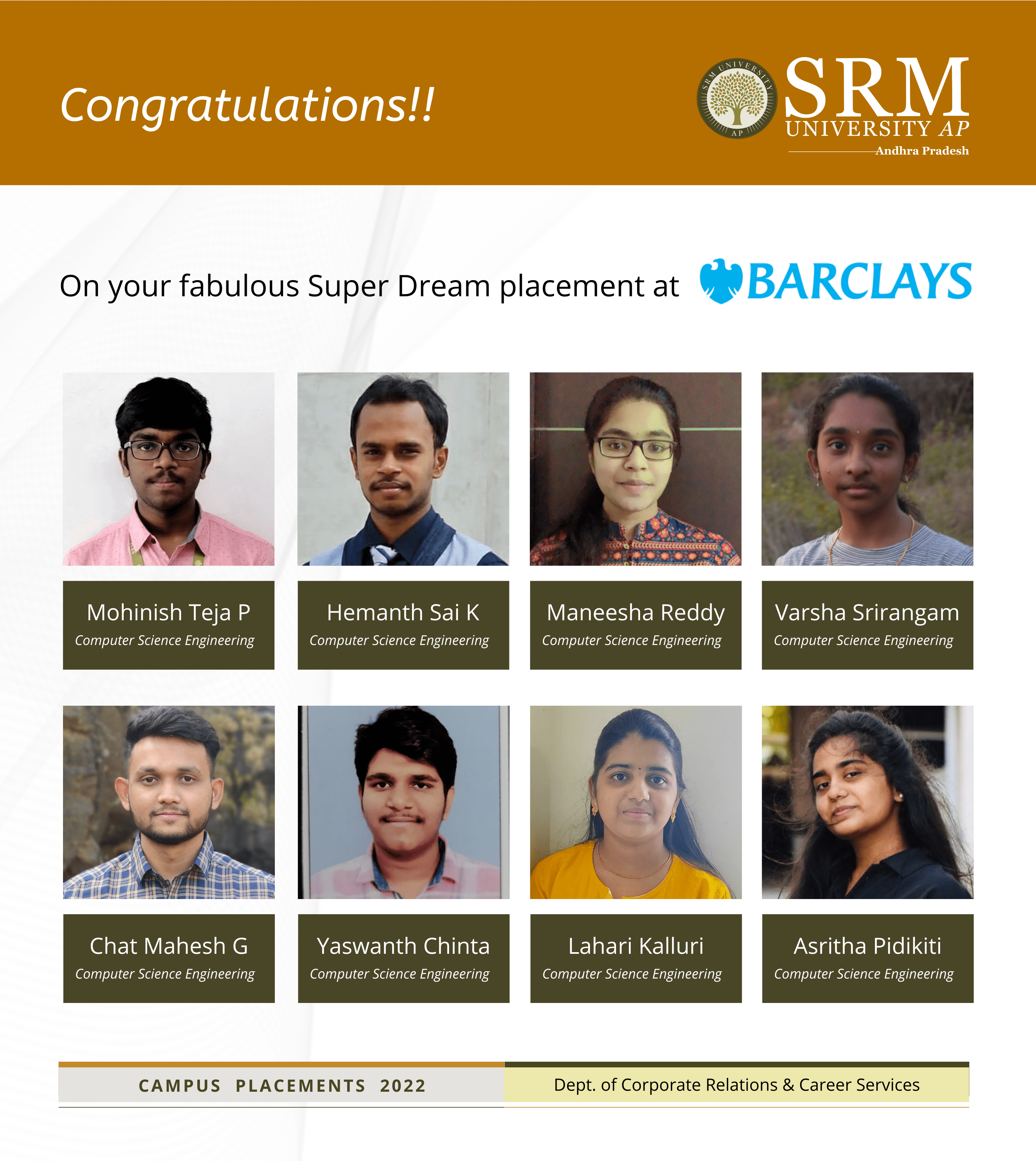 8 students with exciting job offers to their name from world-renowned Barclays Multinational Bank shine up on SRM University-AP banner. Thriving in a competitive environment and levelling themselves up with their goals, these students were able to not only show their polished skills but also their refined mannerisms at expressing it. Their smart work at making best use of the versatile courses offered to them by SRM University-AP has helped them land the job of their dreams.
8 students with exciting job offers to their name from world-renowned Barclays Multinational Bank shine up on SRM University-AP banner. Thriving in a competitive environment and levelling themselves up with their goals, these students were able to not only show their polished skills but also their refined mannerisms at expressing it. Their smart work at making best use of the versatile courses offered to them by SRM University-AP has helped them land the job of their dreams.
Barclays is a coveted dream company for Engineers in India. The Placement Cell at SRM University-AP, CR&CS (Corporate Relations and Career Services) realizes that for specific job roles specific skills would have to be cultivated and the students would need outstanding training along with their academia to fill these roles. The CR&CS counsels the students accordingly so that by the time they sit for the interview they carry the confidence of being the perfect fit for the role.
Maneesha Reddy
“Stop doubting yourself, work hard and make it happen. This is what SRM University-AP taught me. The ISCP course by the CCC department included in the academics helped me become better every day and improved my skills in coding and logical thinking. The training classes provided for the placement and the talks with the experts organised by the CR&CS department helped me know the overview of the placement process. Faculty members really helped us to improve, especially our HOD, Dr Raghunathan, has been the best support to all things associated with the CSE Department. My advice to my juniors is to stay focused on your work, be confident, and follow the curriculum set by the placement department.”
Gunturu Hemanth Sai Kumar
“SRM University-AP curriculum provided a wonderful environment for building up my basics and it also helped me in achieving higher CGPA. The bootcamps and ISCP classes conducted by CCC department provided me the exposure to different company specific problems and improved my problem-solving skills. Placement department also provided me with opportunities by bringing in various companies and that experience helped me clear the interviews. I even got shortlisted for interviews of Marquee and super dream companies like Wells Fargo, NielsenIQ, Navis, Sabre which provided me great exposure to interview handling skills.”
Asritha Pidikiti
“SRM University-AP is a place where you can find an amalgamation of learning, fun, culture, many such life preaching activities. Various workshops and sessions that were held in the University, improved my technical as well as interpersonal skills. My knowledge and confidence go a boost after coming here. SRM University-AP has given me a chance to participate in various committees which helped me to broaden my network. The placement cell has excellent policies and has exceptionally helped me build an industry-ready profile, by arranging seminars and holding aptitude- development lectures.”
Chinta Yaswanth
“I am very glad to start my career with Barclays This could come to pass because CR&CS dept supported us a lot by conducting multiple mock tests. Especially, thanks to the company specific sessions before the drive. These sessions before the drive made all the difference and assured us to face an interview. I whole-heartedly appreciate the virtual help desk despite of the covid situation. I would suggest my juniors to be good at their basics and follow the inputs given by placement team.”
Kalluri Lahari
“You never change your life until you step out of your comfort zone; change begins at the end of your comfort zone.
“I still remember when I joined this university, being a person who used to be shy and introvert, and today, I am here holding an offer would not have been possible without the support from SRM University-AP. The coursework provided by CR&CS department, CDC and domain training helped me to achieve this offer. The CDC department guidance assisted us in improving communication skills and teamwork. Approximately 65 companies lined up for recruitment in a month. SRM University provided us with countless opportunities to fulfil our goals. My advice for the juniors would be to not postpone everything to the last-minute because this might stop you from achieving your dreams.”
Srirangam Varsha
“The curriculum containing industry specific training, mock interviews and group discussions along with company specific training made it easier for us throughout the placement drive. We were familiar with the concepts asked in our coding and interview rounds thanks to the training sessions provided by the CR&CS department. The encouragement I received from my faculty and mentor really helped me when I was at my lowest. I would like to take this chance to thank all my faculty, seniors and CR&CS department because of whose help I did not feel any burden throughout my placement drive and achieved great results. I would suggest to my juniors to take advantage of inputs provided by management to fulfil your dreams and achieve higher heights.”
Paturi Mohinish Teja
“I am very happy to get placed at Barclays. I used to dream about getting placed at a FinTech institution and am very glad to achieve it. Curriculum at SRM University-AP helped me in learning all the required computer fundamentals. CCC training organised by the placement department has helped me a lot during my preparation for placements and interviews. I have been part of Next Tech Lab, which helped me learn a lot of things and build many projects. These projects helped me in Interview. My advice to Juniors would be to build a strong portfolio and never give up in the middle.”
SRM University-AP is proud of their achievements and would like to wish them all the success in their lives as their alma-mater.
- Published in News

